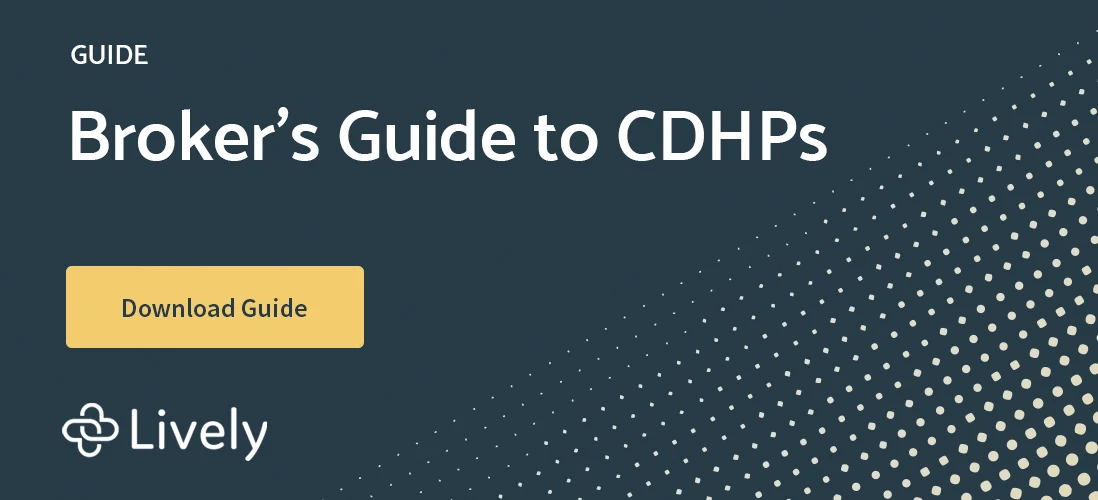The Lively Blog
SIGN UP FOR OUR
Newsletter
Stay up to date on the latest news delivered straight to your inbox
3 Consumer-Driven Health Plan Options for Clients
Renee Sazci · November 30, 2020 · 6 min read

You know that a Consumer-Driven Health Plan (CDHP) provides considerable value for your clients. But for unfamiliar employers, a CDHP might sound complicated. The key to client adoption is how you explain the CDHP. Simplifying definitions can have ripple effects for CDHP adoption and engagement amongst employees too.
Here’s how to explain CDHP options, with quick-reference summaries.
What is a Consumer-Driven Health Plan?
A Consumer-Driven Health Plan (CDHP) is the pairing of a qualifying High-Deductible Health Plan (HDHP) with a tax-advantaged Health Savings Account (HSA), Flexible Spending Account (FSA), or Health Reimbursement Account (HRA).
Qualifying High-Deductible Health Plan
A High-Deductible Health Plan (HDHP) is a health plan defined by a lower monthly premium and a higher deductible. A qualifying HDHP has a minimum deductible and a maximum for out-of-pocket expenses. These amounts are adjusted for inflation and set annually by the Internal Revenue Service (IRS).
2021 Qualifying HDHP
Individual Health Plan
Minimum deductible: $1,400
Maximum out-of-pocket limit: $7,000
Family Health Plan
Minimum deductible: $2,800
Maximum out-of-pocket limit: $14,000
There's one other qualifying characteristic of HDHPs. The individual pays for healthcare costs, up to the deductible, before insurance pays for services. The one caveat is preventive care. All preventive care is covered before the deductible.
Read more about the HDHP.
The Difference Between Qualifying and Non-Qualifying HDHPs
The difference between a qualifying and non-qualifying HDHP are the deductible and out-of-pocket limit. HDHPs with a deductible lower than the IRS minimum, or an out-of-pocket limit higher than the IRS, are not qualifying HDHPs. So, it couldn’t be paired with an HSA to create a CDHP.
The HDHP: What Employers Need to Know

An HDHP is a health plan defined by a lower monthly premium and a higher deductible.
All preventive care is covered before the deductible.
Not all HDHPs can work with an HSA and be a CDHP. Check the HDHP plan to make sure it meets the IRS guidelines:
A qualifying HDHP has a minimum deductible and a maximum for out-of-pocket expenses.
The individual pays for healthcare costs, up to the deductible, before insurance pays for services.
Tax-Advantaged Accounts: HSA, FSA, and HRA
Health Savings Account
A Health Savings Account (HSA) is a savings account that allows the account holder to set aside money on a pre-tax basis to pay for qualified medical expenses. The account holder, employer, and even friends and family can contribute money to an HSA. The contributions are tax-deductible and never expire. So they can be saved for a rainy day, retirement, or to help pay for medical costs today.
Read more about the HSA.
6 Requirements for Employees to Qualify
The following criteria are necessary to be eligible to open and contribute to an HSA:
Must be enrolled in a qualifying HDHP.
An employee can’t have any other supplemental health insurance coverage. Meaning, they can’t be covered under a spouse’s health insurance plan too.
Must not be eligible for or enrolled in Medicare (Part A and Part B) or Medicaid.
Must be under the age of 65.
An employee can’t be claimed as a dependent on someone else’s tax return.
An employee can’t contribute to a Healthcare FSA (HCFSA). However, they are allowed to have a Limited-Purpose FSA (LPFSA) for dental and vision if the HDHP doesn’t cover those services.
2021 Contribution Limits for Individuals and Family Health Plan Coverage
Individual Health Plan (Under Age 55): $3,600 Family Health Plan (Under Age 55): $7,200 Catch-up Contribution (Age 55+*): $1,000
*Once the account holder is 55 or older they can make a catch-up contribution, plus the contribution limit set by the IRS for individual or family health plan coverage.
The HSA: What Employers Need to Know

An HSA offers triple tax savings: pre-tax or tax-deductible contributions, tax-free interest and investment earnings, and tax-free distributions for qualified medical expenses.
Anyone can contribute to an employee’s HSA.
There are six criteria for qualifying for opening and contributing to an HSA. See “6 Requirements for Employees to Qualify” above.
The IRS determines the amount of money that can be contributed annually.
The contributions are tax-deductible and never expire. So they can be saved for a rainy day, retirement, or to help pay for medical costs today.
Flexible Spending Account
A Flexible Spending Account (FSA)—also known as a medical FSA or healthcare FSA—is an employer-provided spending account for eligible medical expenses. Pre-tax dollars are put aside from each paycheck for the FSA. The employer may also choose to contribute. Later, funds are used to pay for qualifying expenses, such as medical care, health-related products, and other services.
Learn more about the Healthcare FSA.
2021 Healthcare FSA Contribution Limit
Per person contribution limit: $2,750
Maximum allowable carryover: $550
3 Eligibility Rules
An employee is eligible to contribute to an FSA if their employer offers one.
Employees can’t contribute to a Healthcare FSA and HSA at the same time.
The FSA doesn’t need to be paired with a specific health insurance plan, like an HDHP.
The Balance
FSA funds must be used within the plan year or risk forfeiting what's remaining.
If the employee has a balance at the end of the year, the employer may offer options, but the employee can only accept one: A rollover of up to $550 in contributions from 2020 to 2021 or a grace period, during which you can use the leftover money. The balance won't affect the employee’s contribution limits for the following year.
The FSA: What Employers Need to Know

An FSA—also known as a medical FSA or healthcare FSA—is an employer-provided spending account.
There are three eligibility rules for opening and contributing to an FSA. See “3 Eligibility Rules” above.
Pre-tax dollars are put aside from each paycheck for the FSA, and the employer may also choose to contribute.
Funds are used to pay for qualifying expenses, such as medical care, health-related products, and other services.
If the employee has a balance at the end of the year, the employer can provide a rollover or grace period. If neither option is available or used, the funds are forfeited to the employer.
Health Reimbursement Account
A Health Reimbursement Account (HRA) is an employer-funded health account that allows tax-free reimbursement of out-of-pocket medical expenses. It is not a healthcare plan and is owned by the employer, not the employee. Employers can choose what is covered under the HRA, as long as they are covered under the provisions set by the IRS.
HRA qualified expenses are generally similar to the qualified expenses of an FSA. Regulations in the Affordable Care Act require employees to be enrolled in their employer’s healthcare plan to be eligible for an HRA.
Learn more about the HRA.
Next, access the data that will make it easier for clients to choose amongst their CDHP options. Download the Broker’s Guide to CDHPs to simplify and accelerate CDHP adoption.

Benefits
2025 and 2026 Maximum HSA Contribution Limits
Lively · June 20, 2025 · 3 min read
On May 1, 2025, the IRS announced the HSA contribution limits for 2026: $4,400 for individual coverage and $8,750 for family coverage. That’s a $100–$200 increase from the 2025 limits, which are $4,300 and $8,550 respectively. If you’re 55 or older, you can still contribute an extra $1,000.

Benefits
What is the Difference Between a Flexible Spending Account and a Health Savings Account?
Lauren Hargrave · February 9, 2024 · 12 min read
A Health Savings Account (HSA) and Healthcare Flexible Spending Account (FSA) provide up to 30% savings on out-of-pocket healthcare expenses. That’s good news. Except you can’t contribute to an HSA and Healthcare FSA at the same time. So what if your employer offers both benefits? How do you choose which account type is best for you? Let’s explore the advantages of each to help you decide which wins in HSA vs FSA.

Health Savings Accounts
Ways Health Savings Account Matching Benefits Employers
Lauren Hargrave · October 13, 2023 · 7 min read
Employers need employees to adopt and engage with their benefits and one way to encourage employees to adopt and contribute to (i.e. engage with) an HSA, is for employers to match employees’ contributions.
SIGN UP FOR OUR
Newsletter
Stay up to date on the latest news delivered straight to your inbox

